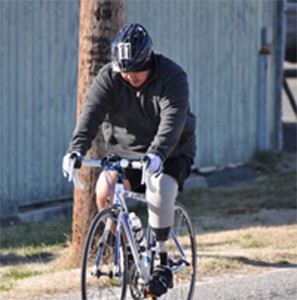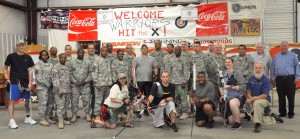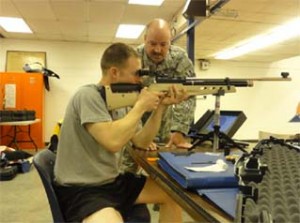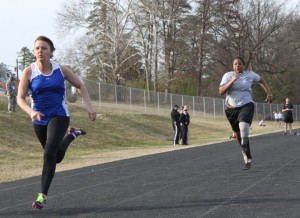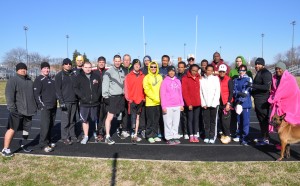
SSG Jorge Haddock-Santiago, (L) and Scott Dault, owner of Crossroads Archery, work to adjust a compound bow set-up donated to Haddock-Santiago through donations from the archery community and private organizations. (Photos by U.S. Army SSG Tracy J. Smith)
By SSG Tracy J. Smith, Fort Stewart, Georgia WTB
It was 2004 when SSG Jorge G. Haddock-Santiago made his first trek halfway around the world, marking the first of numerous deployments. With each combat tour, he suffered some form of injury that, in 2009, would leave the seasoned combat artilleryman unfit for continuation of active service.
Haddock-Santiago resigned to dedicate himself to the new mission of a transitioning Soldier—s to heal and transition back to active service or continue to serve the nation as a Veteran in my community.’
“I racked up a total of six deployments,” Haddock-Santiago said with a thoughtful look in his eyes. “The worst thing that ever happened to me wasn’t so much the physical injuries—it was losing my friends.”
The scars of loss are the hardest to bear for any Soldier especially carrying the guilt of ‘why not me?’
“I had so many things to work through,” he recalled, with a slight ever-present tremor in his hands. “I have come a long way working through my post traumatic stress disorder (PTSD), depression, and other anxieties associated with loss.”
Haddock-Santiago, a native of Puerto Rico, dreamed of a military career that would find him mentoring others. As a young boy, his father introduced him to archery as a form of relaxation, patience, and focus. Upon his assignment to Bamberg, Germany’s Warrior Transition Battalion (WTB) he was reintroduced to archery as a part of the WTB adaptive sports program, never imagining the healing properties the sport would have.
When he was selected to try out for the Army’s 2012 Warrior Games archery team, Haddock-Santiago developed a renewed sense of purpose. Again travelling halfway around the world to Sumter, South Carolina, he was ready to compete to be a part of the third annual Olympic-style games for U.S. military service men and women who have become wounded, ill, or injured.
“I am ready to give my best in memory of my guys because their loss is a burden I carry throughout my life,” he said. “They were my mentors, and because of them I am alive.”
Retired SFC Steven Coleman, the U.S. Army Warrior Games archery coach, felt Haddock-Santiago’s chances for a spot on the team was strong. Unfortunately, opportunity can knock you down as quickly as you are lifted up.
“When military archers are sent this far it’s important that they come prepared,” Coleman explained about his clinic and the imperativeness of being on your ‘A-game.’ “His bow broke and the harsh reality is something like this can immediately end your chances to continue in a competition unless you are able to get that equipment repaired or replaced.”
To Haddock-Santiago it meant he had failed those he wished to honor, and he described how personal that failure was in one word-demoralized.
Soldiers are trained to be acutely responsive in tough situations, assessing then managing.
When it was suggested that a small archery shop in Summerton, South Carolina, , a 30-minute drive from the clinic grounds, may be able to fit him and his battle-buddy, SSG Albert ‘Al’ Louangketh, also a Bamberg WTB Soldier with a bow, they set off on a new mission not realizing another set of life-changing events were about to unfold.
Scott Dault, owner of the Crossroads Archery, was at his post with the same disarming smile that he has greeted customers with for more than 30 years.
“I could tell the young man was upset when he got me on the phone,” Dault recalled. “We just didn’t realize how much it meant to him to be here and how far he had travelled until I talked to him and his buddy Al filled me in a bit when they got here.”
Haddock-Santiago confirmed to his leadership in Germany that he found a bow but it may be a bit out of his budget. His First Sergeant reassured him that Haddock-Santiago should not worry about it adding, “My First Sergeant went one step further and volunteered to pay for it out of his own pocket.”
What the 17-year career Veteran did not realize was his benefits were manifesting before he had even arrived at the little shop in Summerton. Dault, along with his wife Kim, began contacting local archery clubs in the area before the two combat Veterans arrived.
“I got in touch with the president of Bowhunters of South Carolina] David Shull, and the president of Swamp Fox Archers, and they started a ripple effect reaching out to the local South Carolina archery organizations,” Dault said. “Within minutes we had the okay and were able to get Jorge fixed up.”
A customer who frequented Crossroads Archery, Bob Vaden, was so moved by the Soldier’s indomitable spirit and Dault’s determination and this fledgling brotherhood of archers that he reached in his pocket to make a personal donation.
“We look at our lives and know we owe a lot to good folks like Jorge and Al,” Dault said of Vaden’s gift.
Haddock-Santiago was the recipient an $1,100 archery setup courtesy of the Daults and his brotherhood of archers but the group’s altruism did not stop there as the man who traveled half-way around the world has sparked a new opportunity for an unlikely partnership.
“This is about rebuilding their lives,” Coleman added. “These Soldiers and Veterans have given so much as our true one-percenters and this is one of the most therapeutic gifts any of them can be given to rebuild focus, patience and self-confidence.”
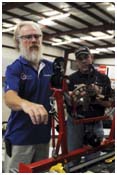
SSG Jorge Haddock-Santiago, (R), a combat Veteran and U.S. Army 2012 Warrior Games archery coach, retired SFC Steven Coleman, work to repair Haddock-Santiago's compound bow during the initial archery preparation and selection clinic. (Photos by U.S. Army SSG Tracy J. Smith)
The curative benefits also match WTC’s mission of providing viable adaptive sports opportunity for the severely injured. Archery’s versatility allows those with severe disabilities to enjoy the benefits using special tactile equipment such as mouth-tabs for those with upper body strength issues or prosthetics and an upright aiming device to assist blind archers.
Dault’s band of archers has donated archery equipment to five additional wounded Soldiers since that momentous day in late January. The gift of a bow set-up can mark a new beginning for many of these Veterans and Soldiers. Although there will be therapeutic benefits knowing someone cares is the most important benefit. This is all due to an encounter born of misfortune and donations from caring communities’ worlds away from the chaos of the battlefield.
“I was never in the military but my dad was a U.S. Air Force pilot,” Dault said describing the importance of what their mission was becoming. “My first employee worked for me while he was in high school and in college joined the South Carolina National Guard. He was deployed a few times and is now a Major.”
Dault chuckles at the last statement and looks around at the mounted trophies and spoils of the hunt that hang around his internationally known shed-shop he deems a ‘one-horse-operation.’
He cannot help but fondly reminisce about the man that he says “types like he talks” and looks forward to seeing his friend when he again travels halfway around the world in March for the next archery-training clinic.



